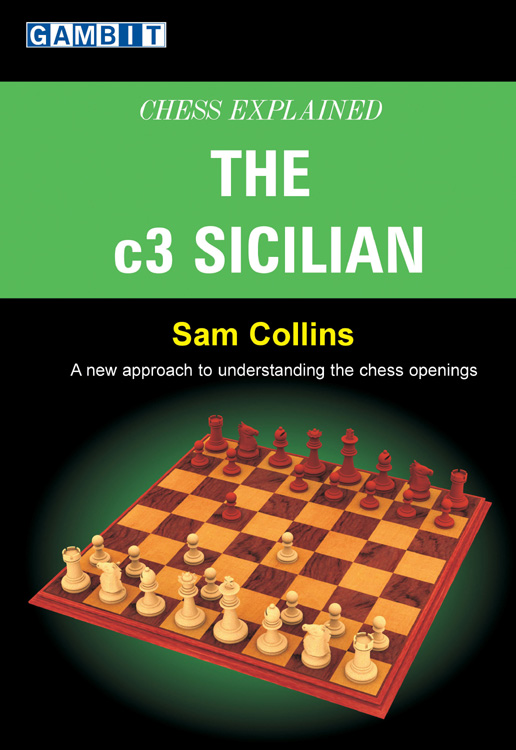Beskrivelse
Fra forlagets beskrivelse av boken (engelsk):
Chess Explained is a new series of books about chess openings. They are not theoretical works in the traditional sense, but more a series of lessons from a chess expert with extensive over-the-board experience with an opening. You will gain an understanding of the opening and the middlegames to which it leads, enabling you to find the right moves and plans in your own games. It is as if you were sitting at the board with a chess coach answering your questions about the plans for both sides, the ideas behind particular moves, and what specific knowledge you need to have.
The c3 Sicilian is one of White’s most popular and poisonous ways to avoid the main lines of the Sicilian. With the forcing line 1 e4 c5 2 c3, White denies his opponent the chance to demonstrate his preparation in some chaotic system; instead Black will have to fight carefully for equality in a more rational position of White’s choosing. There are plenty of tricks and traps in the c3 Sicilian, and the open piece-play that often results can lead to quick attacks and means that careless play will rarely go unpunished.
Sam Collins is a young International Master from Ireland who won the Irish Championship in 2002. He competed in several World and European junior championships and has represented Ireland in four Olympiads, winning a gold medal at Bled in 2002. He is also an experienced chess teacher who has lectured at the Berkeley Chess School in California. His previous book for Gambit was the highly successful general opening work Understanding the Chess Openings.
“Collins does a nice job in two ways; he uses current and relevant GM and IM games played between 2002 and 2006 and he is objective in demonstrating many of Black’s best resources in little-investigated lines. … this book is a nice guide for players looking to start learning the c3 Sicilian or for those who want to see which variations are now topical and to develop their repertoires around current theory.” – Lou Mercuri, Chess Horizons
“…the format is well suited to the average club player who wishes to start using this variation.” – David Mills, Time Trouble
“[Collins’] honesty is wonderfully refreshing, because most opening books are written with some bias, and while Collins may favor White’s chances slightly more than Black’s, he generally ‘calls ’em as he sees them.’ In addition, I found his game commentary to be very instructive, insightful and even enjoyable. There is a fair share of variations in the annotations to the main games, but there is far more prose, and you can actually read the book without using a chess board and still learn plenty in the process. The games are well-chosen and the text is well-written, so it is rather easy to recommend this book to a wide audience, whether you play the c3-Sicilian or not. Of course, those who play this opening as white or face it as black should buy this book without hesitation.” – Carsten Hansen, www.chesscafe.com
“IM Collins has devoted the bulk of the book to Black’s most popular replies with 2…Nf6 and 2…d5 each allocated three of the book’s seven chapters. Particular attention is paid to variations after 1.e4 c5 2.c3 Nf6 3.e5 Nd5 4.Nf3 where White avoids playing an early d4 – GM Tiviakov’s favorite. The Chess Explained series format, where space is limited, requires the author be intimately familiar with his subject matter and Collins clearly is. Against the sequence 1.e4 c5 2.c3 d5 3.exd5 Qxd5 4.d4 Nf6 5.Nf3 Nc6 the move 6.dxc5 is definitely White’s most challenging reply and Collins’ notes to Glavina Rossi-Moiseenko, Sanxenxo 2004, are quite informative.” – IM John Donaldson, www.jeremysilman.com
“With all the different types of positions resulting from this opening, it is not only instructive for white’s perspective, but also for anyone playing the black side against this opening and looking for a line to suit their style. Overall a very nice work, I even saw a few new ideas I had not seen before. I must recommend this book to any aspiring student of the c3 sicilian.” – Andy May, www.nsgchess.com
“Must say that Sam Collins gives in this book a lot of his c3 secrets away” – John Elburg, chessbooks.nl
“I would say that if you really want to take up an anti-Sicilian, and are considering the c3 variation, then this book would be an excellent place to start. It is well written, and easy to follow, with a very useful move tree at the back. Furthermore, though the book is clearly written from an advocate of the white side, it will also be of use to anyone who might be having problems with the opening as black.” – John Lee Shaw, www.chessgateway.com
“He/she who does not have enough time to study the endless variations of the Open Sicilian would be well advised to consult this book. Also players of the Sicilian can, with Sam Collins’ work, prepare themselves for unpleasant surprises.” – Martin Rieger, www.freechess.info










